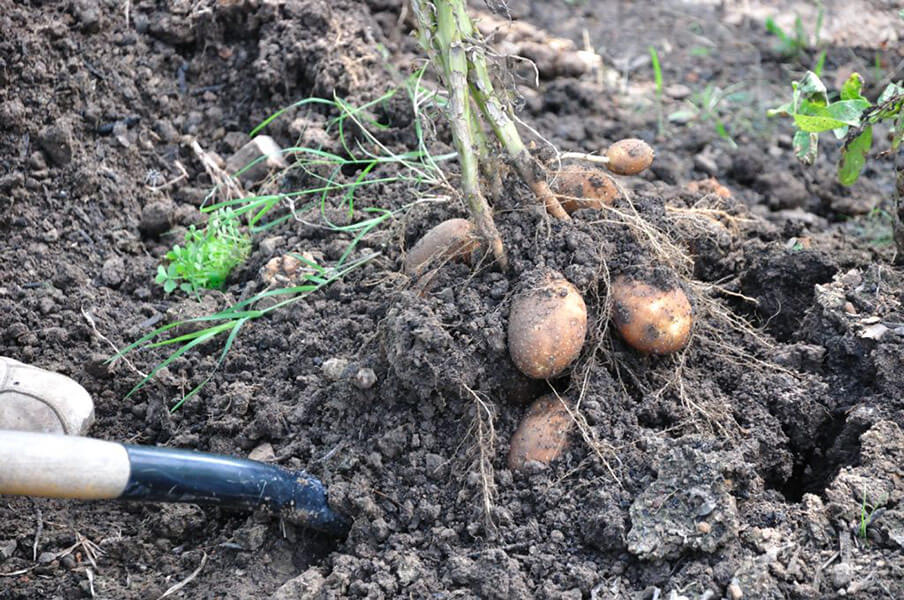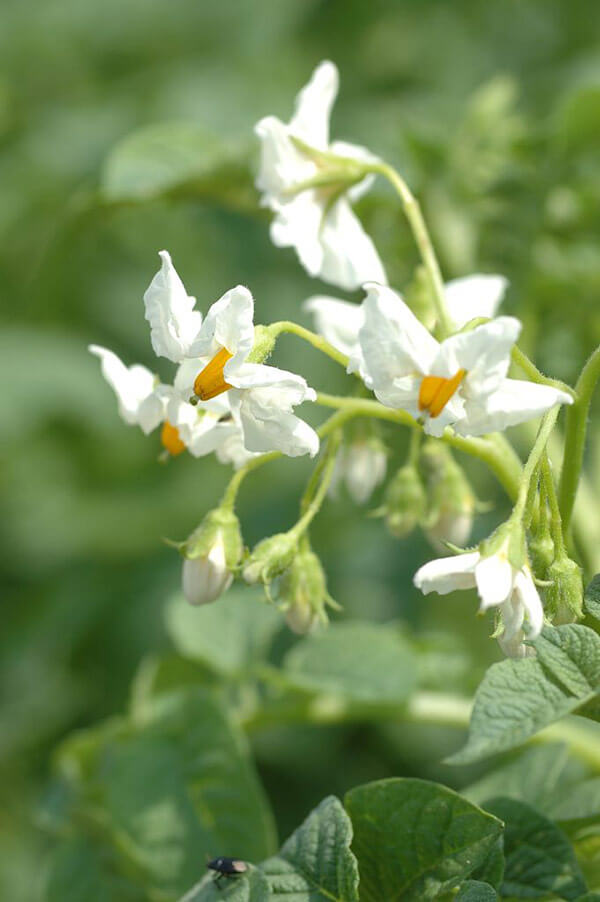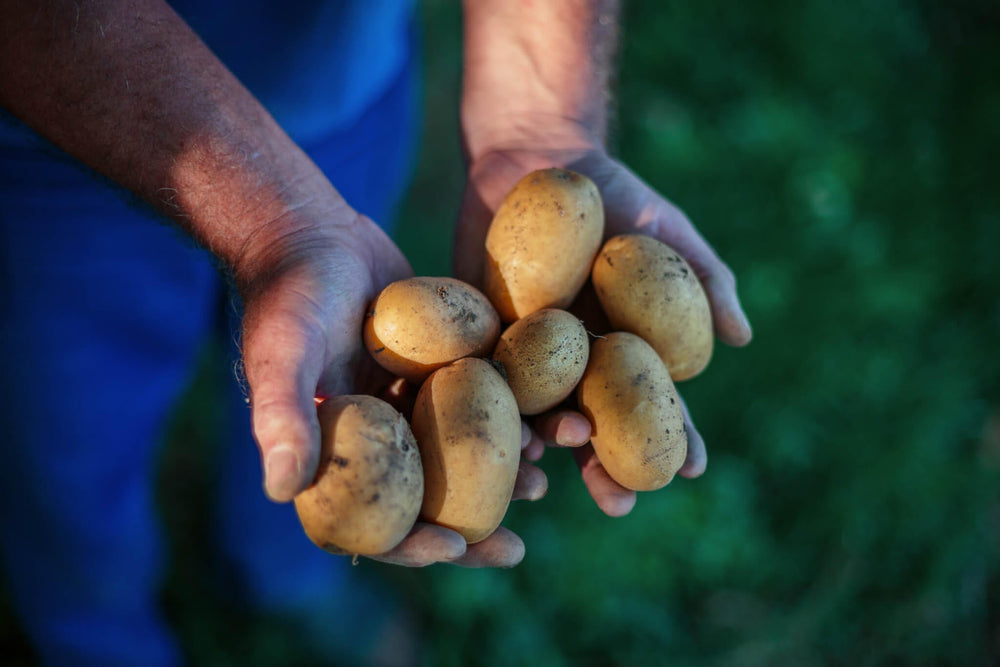An ancient vegetable, potatoes were first cultivated by the ancient Incas in Peru. This crop came to America in 1621, and today is the most popular vegetable in the United States. If you love potatoes and have never tasted a homegrown one, you definitely need to try growing potatoes. Potatoes are cool-season vegetables and yield the best quality and number of tubers in the northern portion of the country. And just so you know: A potato isn't a root but an underground storage stem called a tuber.
Quick Guide to Growing Potatoes
- Plant potatoes during the cool weather of early spring, once the soil can be worked.
- Space potato plants 12 to 14 inches apart in an area with loose, fertile soil that has a pH of 5.8 to 6.5.
- Improve compacted or clay-heavy soils by mixing in several inches of compost or other rich organic matter.
- Once stems reach 8 inches tall, mound soil around the lower half of the stem to protect tubers from sunlight. Repeat in 2 to 3 weeks.
- Space potato plants 12 to 14 inches apart.
- Lay down a 6-inch layer of straw to keep soil temperatures between 60° and 70° F.
- Feed growing potatoes with a continuous-release plant food to maximize your harvest potential.
- Harvest potatoes 2 to 3 weeks after plants flower.
Soil, Planting, and Care
Potatoes are cool-season crops and can survive light frosts. Plant as soon as soil is workable in early spring. Potatoes need fertile, well-drained soil that's loose and slightly acid (pH 5.8 to 6.5). Hard, compacted soil produces misshapen tubers. Improve heavy clay soil the fall before planting by working organic matter into planting beds, or amending the soil with aged compost-enriched Miracle-Gro® Performance Organics® All Purpose In-Ground Soil. You can also grow potatoes in large pots. Fill them with a high-quality potting mix like Miracle-Gro® Performance Organics® All Purpose Container Mix , which also contains nutrient-filled compost.
Potatoes form as tubers 4 to 6 inches below the soil surface. When stems reach 8 inches tall, draw soil up and around plants, covering half of lower stems. Repeat the process two to three weeks later. Potatoes exposed to sunlight turn green, which causes flesh to taste bitter. Keeping tubers covered prevents greening.
Some gardeners grow their potatoes in straw, placing straw around the 8-inch-tall stems instead of soil. This method yields potatoes that you don't have to dig, but simply fish out of the straw. If you use the straw method, be sure to keep your straw layer consistent throughout the growing season. It will most likely break down and need to be topped off during the course of growing the potatoes.
For best results, it's also important to feed potato plants regularly throughout the season with a premium fertilizer like Miracle-Gro® Performance Organics® Edibles Plant Nutrition to ensure they get a steady dose of nutrition.
Maximum tuber formation occurs when soil temperature is 60 F to 70 F. Tuber formation stops when soil temperature hits 80 F. Mulching soil with straw or other organic matter can help reduce soil temperature. Research has shown that maintaining a 6-inch-thick straw layer around potatoes keeps soil temperatures 10 degrees lower. Potatoes are sensitive to drought. Keep plants consistently moist, especially when plants flower and right after, since this is the peak time when tubers are forming.
Move potatoes to a different place in the garden each year to help limit disease and insect problems. For best success, rotate potatoes on a 3-year program, growing them in a different spot for three years in a row before cycling through the growing spots again.
Troubleshooting
Potatoes will develop areas of green skin when they're exposed to direct sunlight during growth. The green areas have a bitter taste because the flesh contains a moderately poisonous compound. When preparing potatoes, cut away any green areas and discard. Potatoes in storage will develop green spots if they're exposed to sunlight or fluorescent light. Keep stored potatoes in darkness. If your storage space isn't completely dark, store potatoes in a box with a lid. Mounding soil or straw around potato stems will protect developing tubers during the growing season. Wedge-shaped leafhoppers feed on potato leaves, causing them to curl or crinkle and edges to turn brown. Flea beetles, which are tiny (1/16 inch), black, and shiny, create white streaks in leaves or small holes. They typically infest plants in late spring. If the infestation is bad enough, it can cause some leaves to die, which will reduce yield. Colorado potato beetles can also ravage plants. Contact your regional Extension office for details on how to handle these pests.
Harvest and Storage
You can harvest new potatoes usually about two to three weeks after plants flower. If soil is loose enough, dig potatoes free with your hands. Otherwise, use a shovel or digging or spading fork to loosen soil near stems. Harvest all potatoes after vines have died. If the growing season has been rainy, wait a few days for soil to dry. It's easier to dig potatoes in dry soil. You'll find tubers 4 to 6 inches below the soil surface. Use a shovel or digging or spading fork, inserting the tool 6 to 10 inches away from the plant stem. Loosen and pry up soil gently, looking and feeling around for tubers.
Brush dry soil from potatoes. Don't wash them if you plan to store them. Newly dug potatoes don't have a tough skin. Handle tubers gently to avoid damaging and bruising them. Curing produces a tougher skin. To cure potatoes, place in a humid spot at roughly 55 F for two weeks.
If you plan to store potatoes into winter, select tubers that are firm and without soft spots. Store in a dark room with high humidity; the temperature should be 38 F to 40 F. Do not store potatoes with apples. Check potatoes frequently for sprout formation; knock off sprouts with your hands and dispose. Do not refrigerate potatoes. Tubers will hold at room temperature for 1 to 2 weeks.
Uses
Use new potatoes with creamed peas, to make soup, or to roast, seasoning with parsley and butter. Prepare mature potatoes in any way you desire. Remember to place peeled or cut potatoes in water to prevent discoloration. Great herb partners for potatoes include dill, fennel, cilantro, basil, chives, parsley, oregano, rosemary, sage, and thyme.








 Herbs
Herbs
 Vegetables
Vegetables
 Fruit
Fruit
 Flowers
Flowers
 Succulents
Succulents


